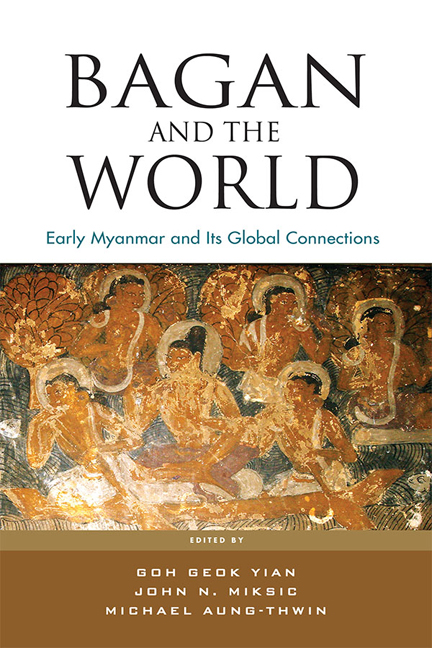Book contents
- Frontmatter
- Contents
- Preface
- Contributors
- 1 Keynote: The Myth of “Splendid Isolation”
- 2 Analysis of Construction Technologies in Pyu Cities and Bagan
- 3 Khraung-kaik Pitaka-taik: 16th-Century Repositories for Buddhist Scriptures in Mrauk-U
- 4 Religious Symbols as Decorations on the Sikhara of Ancient Monuments in the Late Bagan Period
- 5 The Viṣṇu on Garuḍa from the Nat Hlaung Kyaung Temple, Bagan
- 6 A Thousand Years before Bagan: Radiocarbon Dates and Myanmar's Ancient Pyu Cities
- 7 Ta Mok Shwe-Gu-Gyi Temple Kyaukse and Bagan
- 8 Silver Links! Bagan–Bengal and Shadowy Metal Corridors: 9th to 13th Centuries
- 9 Positioning Bagan in the Buddhist Ecumene: Myanmar's Trans-Polity Connections
- 10 Orthogeneity, Settlement Patterns and Earthenware Pottery Distribution in Bagan
- Index
- Miscellaneous Endmatter
7 - Ta Mok Shwe-Gu-Gyi Temple Kyaukse and Bagan
Published online by Cambridge University Press: 01 February 2018
- Frontmatter
- Contents
- Preface
- Contributors
- 1 Keynote: The Myth of “Splendid Isolation”
- 2 Analysis of Construction Technologies in Pyu Cities and Bagan
- 3 Khraung-kaik Pitaka-taik: 16th-Century Repositories for Buddhist Scriptures in Mrauk-U
- 4 Religious Symbols as Decorations on the Sikhara of Ancient Monuments in the Late Bagan Period
- 5 The Viṣṇu on Garuḍa from the Nat Hlaung Kyaung Temple, Bagan
- 6 A Thousand Years before Bagan: Radiocarbon Dates and Myanmar's Ancient Pyu Cities
- 7 Ta Mok Shwe-Gu-Gyi Temple Kyaukse and Bagan
- 8 Silver Links! Bagan–Bengal and Shadowy Metal Corridors: 9th to 13th Centuries
- 9 Positioning Bagan in the Buddhist Ecumene: Myanmar's Trans-Polity Connections
- 10 Orthogeneity, Settlement Patterns and Earthenware Pottery Distribution in Bagan
- Index
- Miscellaneous Endmatter
Summary
The processes by which Buddhism was introduced and mediated in the culturally specific context of Kyaukse are exemplified by the Ta Mok Shwe-gu-gyi temple complex. While to some degree its development was stimulated through its relation to Bagan, Ta Mok's principal identity is local. In this context, it deepens our understanding of the complex interrelationships and definitions that constituted Bagan and questions normative concepts of centre and periphery. The archaeology of Ta Mok authenticates national traditions of the founding of the eleven khayaing of Kyaukse by King Anawrahta (1044–77 CE) (Than Swe 1994, p. 19). Pyu (2nd to 9th century CE) pottery, burnished wares, and bones possibly dating to 3000 bce from Ta Mok highlight earlier connections to other regions. Thus, in both its prehistoric and historic dimensions, the Ta Mok evidence demonstrates the nuanced manner in which global ideas and styles were used to address issues of active local concern.
Chronology of the Site
The Shwe-gu-gyi temple complex, 9.65 kilometres west of Kyaukse, is located inside the Ta Mok fort, the only one of the nine Pan Laung Shwe-gu (“golden cave”) located within the khayaing fort wall. Based on the plan, brickwork and iconography, five features of the complex are dated here to the reign of Anawrahta: the central temple, two gu or small caves on the southwest of the complex, the thein or ordination hall, the innermost of the encased images of the Buddha in the southwest gu, and a row of three images of the Buddha in the thein and the palin or thrones of these images.
Based again on stylistic grounds, we argue that Myit-taw Narapatisithu (1174–1211 CE) enlarged the central temple and added an upper storey. The interior and upper storey of the main temple and other buildings such as the ordination hall and images of the Buddha were repeatedly encased and redecorated from the 11th to 14th century ce. However, as described below, the many unique aspects of the temple set out new parameters for the art, patronage and chronology of wider Bagan.
The earliest structure that has been unearthed is located on the northeast of the two-storey temple: a square building provisionally dated to the 8th to 10th century ce late Pyu period, with burial urns at the foundation level.
- Type
- Chapter
- Information
- Bagan and the WorldEarly Myanmar and Its Global Connections, pp. 122 - 152Publisher: ISEAS–Yusof Ishak InstitutePrint publication year: 2017



